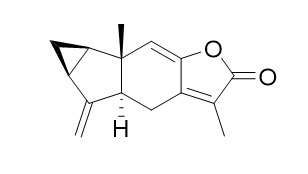Chloranthalactone A
Reference standards.
Inquire / Order:
manager@chemfaces.com
Technical Inquiries:
service@chemfaces.com
Tel:
+86-27-84237783
Fax:
+86-27-84254680
Address:
1 Building, No. 83, CheCheng Rd., Wuhan Economic and Technological Development Zone, Wuhan, Hubei 430056, PRC
Providing storage is as stated on the product vial and the vial is kept tightly sealed, the product can be stored for up to
24 months(2-8C).
Wherever possible, you should prepare and use solutions on the same day. However, if you need to make up stock solutions in advance, we recommend that you store the solution as aliquots in tightly sealed vials at -20C. Generally, these will be useable for up to two weeks. Before use, and prior to opening the vial we recommend that you allow your product to equilibrate to room temperature for at least 1 hour.
Need more advice on solubility, usage and handling? Please email to: service@chemfaces.com
The packaging of the product may have turned upside down during transportation, resulting in the natural compounds adhering to the neck or cap of the vial. take the vial out of its packaging and gently shake to let the compounds fall to the bottom of the vial. for liquid products, centrifuge at 200-500 RPM to gather the liquid at the bottom of the vial. try to avoid loss or contamination during handling.
Inflammation2015, 38(1):445-55
Molecules.2015, 20(10):19172-88
Antimicrob Agents Chemother.2024, e0031424.
Korean Journal of Pharmacognosy2019, 50(4):285-290
Nutrients2020, 12(3):811.
J Pharm Biomed Anal.2024, 247:116257.
ACS Pharmacol Transl Sci.2024, 7(2):395-405.
Ann Transl Med.2019, 7(23):731
Academic J of Second Military Medical University2018, 39(11)
Front Plant Sci.2022, 12:811166.
Related and Featured Products
Planta Med. 2010 Mar;76(4):365-8.
Anti-leishmanial lindenane sesquiterpenes from Hedyosmum angustifolium.[Pubmed:
19830657]
The aim of this work is the isolation of anti-leishmanial compounds from the ethyl acetate extracts of the bark of HEDYOSMUM ANGUSTIFOLIUM.
METHODS AND RESULTS:
We have successfully isolated and characterized five sesquiterpenes: one new compound (oxyonoseriolide, 1), one compound isolated for the first time from a natural source (hedyosmone, 2), and three known sesquiterpenes (onoseriolide, 3; Chloranthalactone A, 4; and spathulenol, 5) that had not been previously isolated from H. ANGUSTIFOLIUM.
CONCLUSIONS:
The biological activities of 1- 5 showed that onoseriolide ( 3) was the most active compound against axenic amastigotes from LEISHMANIA AMAZONENSIS and L. INFANTUM. Moreover, it was still active on the intramacrophagic amastigotes of L. INFANTUM. The isolated compounds have also been tested on PLASMODIUM FALCIPARUM and against various mammalian cell lines.



